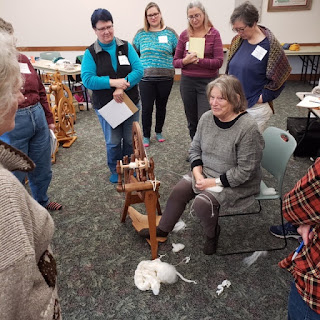Judith McKenzie: "Spinning Fiber for Consistency" wows Spinners.
 |
| Judith McKenzie: Perfecting worsted and woolen spun yarn |
 |
| Note Size progression and 45 degree ply |
However, YOUR wheel is adjustable is two ways, the brake tension and the size of the pulley (whorl). Begin with the middle pulley and brake finger tight. Judith suggests first, tweaking the brake tension a "frog's hair" to loosen or tighten as you spin to get your desired size of yarn. If that doesn't work, move up or down your whorl. Spin for your fibers preparation, ie, top, rolag, roving, lock, combed or carded. For thicker yarn increase your brake tension and/or increase your whorl size. For thinner yarn, decrease brake tension and use the smaller whorl. Practice with each new fleece until you have a series of ~8 samplings to adapt your wheel to your spinning style and your fiber prep. The sample should exhibit a 45 degree ply.
 |
| Judith spining boucle, spinning the base and fuzzies all at once. |
 |
| Spinning using a carder to hold the fiber |
"If you need a little refresher, worsted spinning means that you're using combed longwool top and that you're spinning with a short forward draw with no twist in the drafting zone. Woolen means you're using a carded preparation (fibers going in all directions) and you're spinning with a long backward draw with twist in the drafting zone. Woolen spinning is usually done with shorter wool" (Greg Cotton)
If you're having trouble with your 'deathgrip' on the unspun fibers, try using a carder as shown. It will allow you to control the spin without the finger stress. Such tidbits were shared throughout the two day workshop.
 |
| Plying with a little help from her friends. |
Judith also shared some natural dying techniques, such as Lichen. This Lichen grows wild around the base of trees and usually appears chartuese/greenish in color and produces green when used with hot water over a 24 hour incubation period.
Note in this picture, this sample dyed shades of yellow and gold. Interesting note to self: Using the water from one city versus another changed the color produced while using the exact same method.
As we practiced, Judith continued to share her vast knowledge of the history of fiber from its ancestral roots in the stone ages to day. What a wealth of knowledge in one lady.



Comments
Post a Comment